The Corsair Carbide 600Q Case Review: Upside Down But Right On
by E. Fylladitakis on September 12, 2016 8:30 AM EST- Posted in
- Cases/Cooling/PSUs
- Corsair
- ATX
- E-ATX
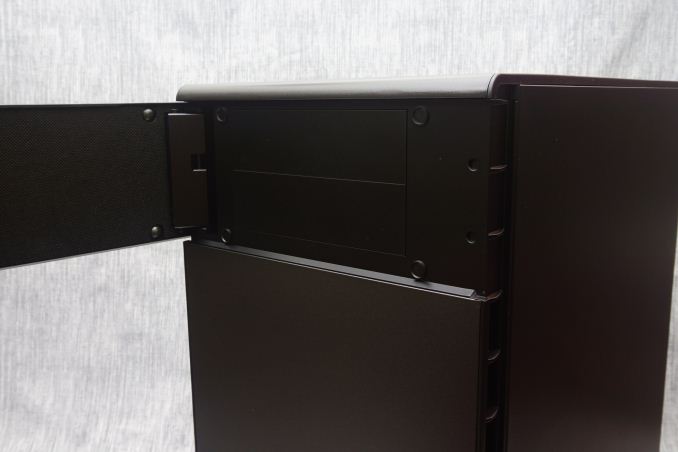
The concept of reversed and rotated motherboard tray cases is not new. Such designs primarily received attention with the introduction of the BTX form factor, when manufacturers were trying to make their products both ATX and BTX compatible. The prime example is probably the first generation Cooler Master Stacker, both for its design and what followed. The Stacker was successful enough to spawn a whole family of cases, however none of them retained the original's reversable tray. And, as things turned out, that's an accurate reflection of the larger market: ever since the BTX form factor has been abandoned, there are very few cases with rotated and reversed motherboard trays. Those few cases that still offer alterable trays are considered unordinary, special designs.
Introduction
It is just such a special case that we are taking a look at in this review: the Corsair Carbide 600Q Inverse ATX case. Corsair introduced the Carbide 600Q as a high quality product that is focused on utility and low-noise operation. The primary attraction of this case however is its interior design. As the name suggests, the Carbide 600Q has an inversed motherboard tray that, according to the company, should enhance the thermal performance of the system. It goes without saying then that we'll be paying special attention to that claim for this review, and seeing how it compares against typical ATX designs.
| Corsair Carbide 600Q | ||
| Motherboard Size | EATX, ATX, Micro-ATX, Mini-ITX | |
| Drive Bays | External | 2 × 5.25" |
| Internal | 2 × 3.5" 3 × 2.5" |
|
| Cooling | Front | 2 × 120 mm or 2 x 140 mm (2 × 140 mm included) |
| Rear | 1 × 140 mm (included) | |
| Top | - | |
| HDD | - | |
| Bottom | 3 × 120 mm or 2 x 140 mm (not included) | |
| Radiator Support | Front | Up to 280 mm |
| Rear | Up to 140 mm | |
| Top | - | |
| Side | - | |
| Bottom | Up to 360 mm | |
| I/O Port | 2× USB 3.0, 2× USB 2.0, 1× Headphone, 1× Mic | |
| Power Supply Size | ATX | |
| Clearances | HSF | 200 mm |
| PSU | 210 mm | |
| GPU | 370 mm | |
| Dimensions | 535 mm × 260 mm × 454 mm 21.06 in × 10.24 in × 17.87 in |
|
| Prominent Features | · Inverse ATX Layout: With this new layout, airflow is directed at the hottest devices in your system; the GPU and CPU, and not wasted on drive cages. · (Windowed Version Only): Full side panel window: A gorgeous, panoramic full side panel window shows off your components, and the tool-free latch and hinge lets you get in and out of the case easily. · Steel Exterior: Get rid of those plastic cases - the 600C has full steel front and top panels for extra durability and good looks. · Three included AF140L fans: Great airflow doesn't have to be noisy. The AF140L fans can push good amounts of air across your hottest devices with less distracting fan hum, and the three-speed fan controller lets you decide exactly how fast they run. · PSU and 5.25" Bay Cover: Clean up the inside of your case by tucking all those cables and less-attractive drives behind a clean, refined PSU and 5.25" bay cover. Or remove them for assembly - it's up to you. · Water-cooling Ready: Fit up to a 280mm radiator up front and up to a 360mm radiator on the bottom - along with the 140mm rear fan mount, that means your next build can be both cool and beautiful. · Easy to Clean: Easy-access dust filters on the front and bottom mean you'll never spend more than a minute getting dust out of your system. · Easy to Build: Tool-free drive installation, side panel access, and tons of cable routing options and tie downs means you can spend less time building your PC and more time using it. |
|
| Price | $140 | |
Packaging & Bundle
Corsair supplies the Carbide 600Q in a monochromic and aesthetically simple, but very sturdy cardboard box. The case is well protected inside it by two thick Styrofoam slabs and a nylon bag.
The company kept the main bundle of the case down to the basics. Only the necessary black mounting hardware, a manual and a few short cable ties are supplied alongside with the 600Q.
By default, the case has two 140 mm fans installed. A third 140 mm fan however is supplied along with the case, packed along with its mounting screws and a thank you note inside a small box. The user can decide the mounting location of this 140 mm fan, or choose not to install it at all in favor of lower noise levels.


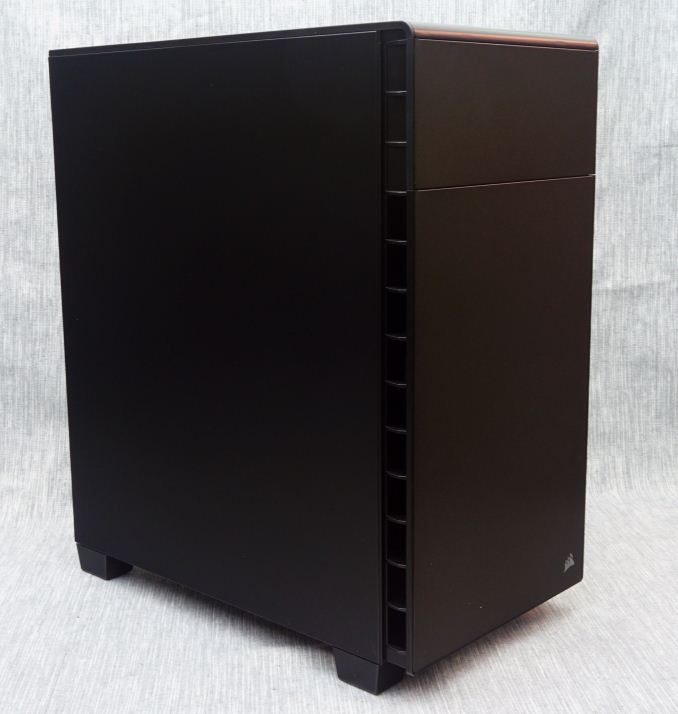
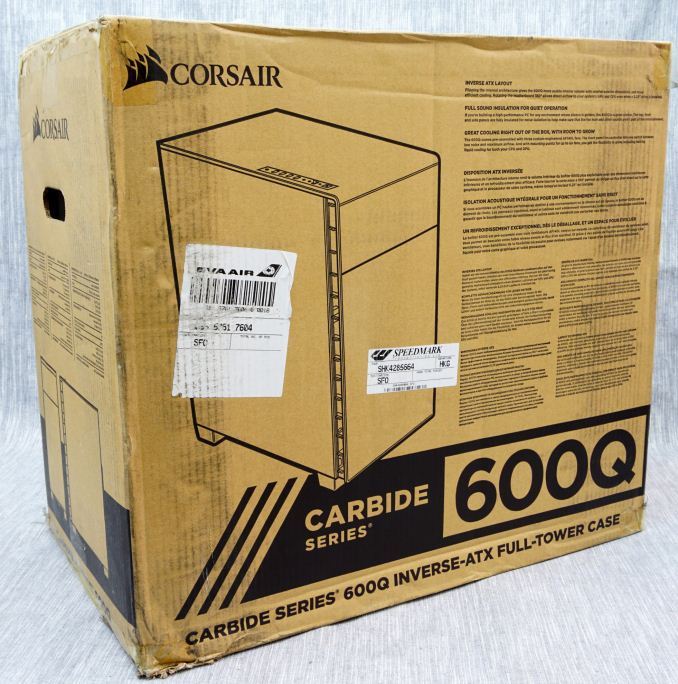
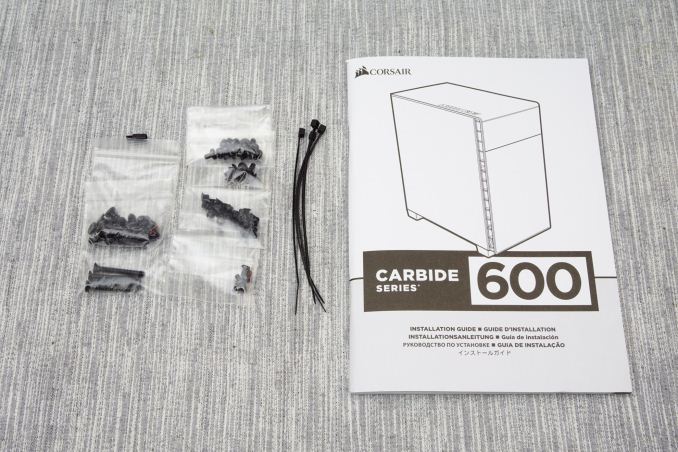
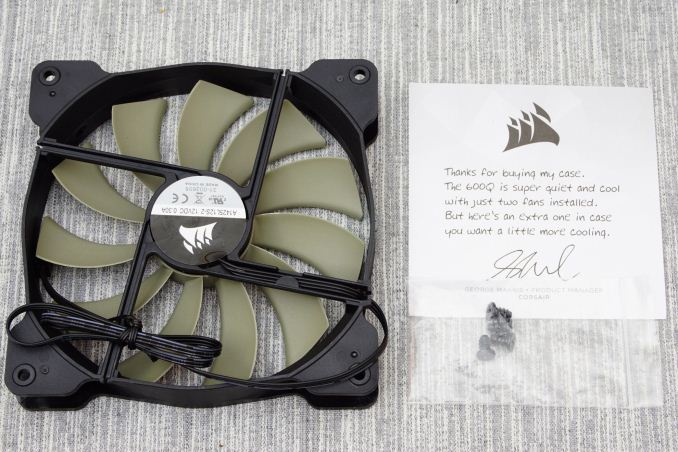








46 Comments
View All Comments
prisonerX - Monday, September 12, 2016 - link
Who was the genius who shot this black case against a white background with simple metering and without exposure compensation? I can't see a thing.3ogdy - Monday, September 12, 2016 - link
Everyone and their momma talking here about the reasons why PSU are bottom-mounted nowadays instead of having them top-mounted.The real reason for putting the PSU on the bottom of the case is to make way for big water cooling systems to properly fit and grab air from a place close to the CPU. They first put them on the back of the case, some chose the front, right underneath the HDD cage and behind the front intake fan (e.g. Alienware Predator 2) and now the trend is to avoid running tubes all over the case and thus put the (double) radiators on the top of the case.
Putting the PSU farther from your ears makes the computer seem more silent, unless your WC pump and fans are on fixed to the top panel...then not so much. Oh well, that's what Noctuas are for.
m16 - Tuesday, September 13, 2016 - link
That's not an original design, it's more of an old school design. I prefer the bottom/separated compartment design, but I can see the draw to it being on top.Corsair hassle really good cases, but I'd wager that my favorite cases are their bigger ones for expandability, and the smallest ones for space saving reasons.
Most if not all of the carbide series are pretty elegant if I must say so. I have had two and I highly recommend them to those who want an unconscious case.
Dustin Sklavos - Tuesday, September 13, 2016 - link
Figures E. would get what we were trying to do with this case. ;)The core concept and layout of the design is mine, but the engineering, ID, and all the details that went into this were part of a larger team as most products are here at Corsair. But if you ever wanted to know what kind of case a former case reviewer might design, this is an example.
When I reviewed cases, the main issue with silent cases was airflow. Their airflow was often so mediocre that it tended to cancel out any benefits to the silent design. Flipping the interior had multiple advantages:
1. Allowed the use of extensive liquid cooling in the "top" (now bottom) of the chassis.
2. Allowed us to put the PSU and 5.25" bays on the same plane.
3. Allowed us to seal off the top of the case, preventing noise from escaping.
As a sidenote, in our thermal testing we found that the third fan barely affected performance but did affect noise, which is why we leave it spare.
Thank you for the positive review. :)
Butioncerhat447 - Tuesday, June 12, 2018 - link
the expiry day, the CVV code as well as your email address https://mypremiercreditcard.me/ To access a credit card declaration at mypremiercreditcard.Edward577 - Wednesday, June 20, 2018 - link
The AMAZING newer version of the 7300. https://www.mixcloud.com/TopRatingBeardTrimmer1/ A man that is well groomed undoubtedly puts http://beardtrimmerulitmate.soup.io/post/655837248... the beard trimmer reviews you will see on https://shopbeardtrimmer.squarespace.com All trimmers of a good enough top quality https://canvas.instructure.com/courses/1341594/ass... that have disposable batteries. http://beardtrimmerrating.wikidot.com/ you have a brief beard, bristle.